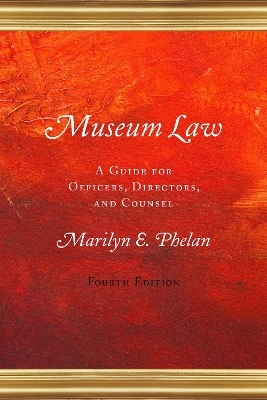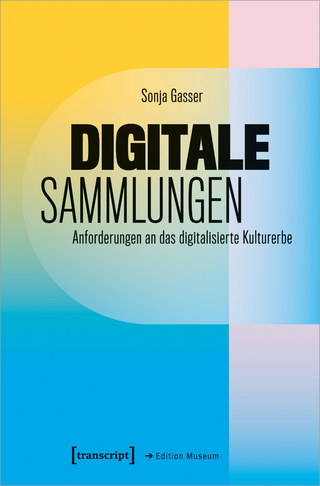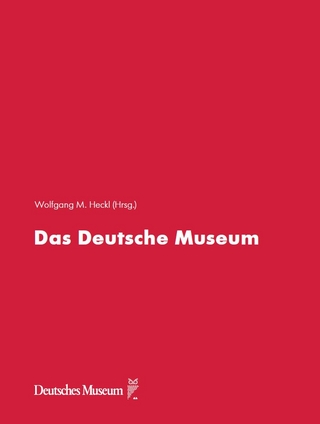
Museum Law
Rowman & Littlefield Publishers (Verlag)
978-0-7591-2434-9 (ISBN)
This authoritative guide:
·begins naturally with laws protecting art and artists (include artists’ freedom of expression, invasion of privacy, right of publicity, and trade laws),
·moves on to protection of artists’ property rights through copyright laws, and then
·goes into international laws and conventions (with full coverage of the Hugue Convention for the Protection of Cultural Property in the Event of Armed Conflict, the UNESCO Convention on the Means of Prohibiting and Preventing the Illicit Import and Export and Transfer of Ownership of Cultural Property, and the UNIDROIT Convention on the International Return of Stolen or Illegally Exported Cultural Objects),
·features full coverage of U.S. laws protecting cultural heritage such as the Antiquities Act, the Historic Sites Act, the National Historic Preservation Act, the National Film Preservation, State Preservation Acts, and the National Stolen Properties Act
·includes detailed coverage of U.S. laws protecting our natural heritage such as the Lacey Act, the Endangered Species Act, and the Marine Mammal Protection Act
·features much needed current coverage of laws affecting the operation of museums, ranging from organizational structure and accounting to governance and use of guards and volunteers
·includes invaluable details of laws related to museum collections, including:
opurchases
oloans
ogifts
odeaccessioning
·detailed coverage of laws and regulations governing the tax-exempt status for museums, including how to fill out required forms
·unprecedented attention to museums’ unrelated business taxable income from such increasingly common activities as gifts shops, snack bars, travel tours, and sponsorships.
No museum, cultural heritage site, or historical site can afford to be without this authoritative guide.
Marilyn E. Phelan, JD, (with honors), University of Texas School of Law, PhD, Texas Tech University, was the recipient of the Paul Whitfield Horn Professor of Law at Texas Tech University, which is one of the highest honors Texas Tech University can bestow on its professors. Phelan also has served as a professor of museum science at Texas Tech University. Phelan is a certified public accountant and is certified by the Texas Board of Legal Specialization as a specialist in tax law. She was given a YWCA Woman of Excellence award and was named a Super Lawyer by Texas Monthly. In 2011, the American Bar Association Section of Business Law, Nonprofit Committee, awarded her the ABA Outstanding Nonprofit Academic Award for contributions and achievements in the field of nonprofit law.
TABLE OF CONTENTS
TABLE OF SELETED CASES
PREFACE
ACKNOWLEDGMENTS
PART I–OPERATIONS
CHAPTER I. MUSEUM GOVERNANCE: LAWS AND PRINCIPLES
A. Organizational Structure of a Museum
1. Charitable Trust
2. Association
3. Nonprofit Corporation
a. Members
b. Directors
c. Officers
d. Employees
B. Governance Principles for Museum Officials
1. Standards of Conduct for Trustees and Directors
a. Duty of Care
b. Duty of Loyalty
2. Disposition of Assets upon Dissolution
3. Enforcement of Fiduciary Obligations
a. Immunity from Liability
b. Standing (Right) to Sue
c. Indemnification of Directors
4. Federal Regulation
a. Self-Dealing–§ 4941 of the Internal Revenue Code
b. Excess Benefit Transactions–§ 4958 of the Internal Revenue Code
C. Accounting for Museums
1. Statement of Financial Position
2. Statement of Activity
3. Statement of Cash Flows
4. Fund Accounting
5. Museum Collections
6. Donated Services and Materials
7. Governmental Reporting Requirements
CHAPTER II. MUSEUM PERSONNEL
A. Employment Laws and Principles
1. At-Will Employment Doctrine
2. Civil Rights Act of 1964 (Title VII)
3. Equal Pay Act
4. Age Discrimination in Employment Act
5. Vocational Rehabilitation Act
6. Veterans Employment Emphasis under Federal Contracts Act
7. Americans with Disabilities Act
8. Fifth and Fourteenth Amendment Requirements
a. Property Interest
b. Liberty Interest
c. Procedural Due Process
9. Safety Requirements
B. Employee’s Tortious Conduct
1. Negligence
2. Museum’s Vicarious Liability
3. Defenses
4. Immunity from Liability
5. Strict Liability
6. Special Liability Rules for Owners of Land
a. Trespasser
b. Trespassing Children
c. Licensee
d. Invitee
e. Abolition of Categories
7. Need for Insurance
C. Use of Guards
D. Use of Volunteers
E. Unionization of Museum Employees
1. Selection of a Labor Representative
2. Duty to Bargain in Good Faith
3. Subject Matter of Bargaining
4. Unfair Labor Practices
5. Strikes
6. Agency or Union Shops an Right to Work Laws
7. How Labor Laws Affect a Museum
CHAPTER III. OBTAINING AND MAINTAINING TAX EXEMPT STATUS
A. Section 501(c)(3) Status
1. Inurement
2. Commercial Activities
3. Involvement in a Partnership
4. Shareholder in a For-Profit Corporation
5. Lobbying Activities
a. Definition of Lobbying
b. Electing Organization
c. Nonelecting Organization
d. Exceptions to Lobbying
e. Penalty Taxes
B. Standing (Right) of the Public to Challenge Tax-Exempt Status
C. Museum with Public Charity Status for Tax Purposes
1. Disqualified Person Characterization
2. Section 509(a)(1) Public Charity
a. Support Test
b. Facts and Circumstances Test
3. Unusual Grants
4. Section 509(a)(2) Public Charity
a. Support Test
b. Investment Income Tesst
5. Section 509(a)(3) Public Charity
a. Organizational Test
b. Operational Test
c. Relationship with Publicly Supported Charities
I. Type I–Operated, Supervised, or Controlled by
II. Type II–Supervised and Controlled in Connection With
III. Type III–Operated in Connection With
6. Procedures to Obtain Public Charity Status
7. Annual Reporting Requirements
8. Involvement in Excess Benefit Transactions
a. Disqualified Persons under Section 4958
b. Excess Benefit Transaction
D. Museum with Private Foundation Status for Tax Purposes
1. Classification as a Private Foundation
a. Charitable Contribution Deduction
b. Excise Tax
c. Self-Dealing
d. Failure to Distribute Income
e. Excess Business Holdings
f. Jeopardizing Investments
g. Taxable Expenditures
2. Private Operating Foundation
a. Income Test
b. Assets Test
c. Endowment Test
d. Support Test
3. Termination of Private Foundation Status
a. Termination Tax
b. Voluntary Termination
4. Annual Returns
CHAPTER IV. FUNDING AND UNRELATED BUSINESS TAXABLE INCOME
A. Funding for Museums
1. Federal Funding
2. Grants from Private Nonoperating Foundations
3. Fund Raising Activities
4. Licensing Agreements
a. Basic Principles of Contract Law
b. Terms of Sales Agreement
c. Statute of Frauds (Requirement that Contract be in Writing)
d. Rejection of Goods
e. Risk of Loss
f. Warranties
B. Tax Issues Relating to Funding Obtained through Donations
1. Charitable Contribution Deduction
2. Deferred Giving
3. Valuation
4. Disclosure Requirements
C. Unrelated Business Taxable Income
1. Income from an Unrelated Trade or Business
a. Not Substantially Related to Museum’s Charitable Purposes
b. Regularly Carried On
c. Exploitation of a Museum’s Exempt Function
2. Specific Exclusions from Unrelated Trade or Business
3. Gift Shops
4. Snack Bar and Cafeteria
5. Parking Lot
6. Travel Tours
7. Sale of Art Works
8. Fund-raising Activities
9. Income from Advertising
10. Income from Sponsorships
11. Trade Shows
12. Income from Investments
a. Rental Income
b. Royalty Income
13. Income from a Controlled Organization
14. Income from Unrelated Debt-Financed Property
a. Average Acquisition Indebtedness
b. Average Adjusted Basis
c. Debt/Basis Percentage and Taxable Income
PART II–MUSEUM COLLECTIONS
CHAPTER V. ACQUISITIONS
A. Purchases
1. Authentication--Forgeries
2. Acquiring Good Title
B. Gifts
1. Legal Requirements
2. Cy Pres Doctrine
C. Loans
1. Law Relating to Bailments
2. International Loans of Artistic Treasures
3. Exemption of Loans from Seizure
D. Natural and Cultural Heritage Restrictions
E. Deaccessioning
CHAPTER VI: STOLEN AND ILLEGALLY IMPORTED ARTIFACTS IN COLLECTIONS
A. Importation Laws on Artifacts from Other Countries
1. Pre-Columbian Monumental Architectural Sculpture or Mural Act
2. Cultural Property Implementation Act
3. National Stolen Property Act
B. Return/Restitution of Stolen and Illegally Exported Artifacts
1. Statute of Limitations
2. Due Diligence Requirement
3 Laches Defense
4. Claims From and Against Foreign Governments
C. Mediation to Settle Disputes
CHAPTER VII: ARTISTIC COLLECTIONS AND RIGHTS OF ARTISTS
A. Moral Right
B. Droit de Suite
C. Freedom of Expression
D. Defamation
E. Invasion of Privacy
F. Right of Publicity
G. Unfair Competition
CHAPTER VIII. COPYRIGHT LAWS
A. Sources and Extent of Copyright Protection
B. Original Work of Authorship
C. Artists’ Moral Right
D. Fair Use of Copyrighted Works
E. First Sale Doctrine
F. Means to Secure Copyright Protection
G. Liability for Infringing Copyrighted Works
H. Application of Copyright Laws in a Digital Environment
I. Protection and Liability Outside of Copyright Laws
1. Right of Publicity
2. Unfair Competition
3. Trademarks
4. Misappropriation
5. Trade Dress
J. Licensing of Digital Images
PART III–HERITAGE
CHAPTER IX. NATURAL HERITAGE PROTECTION
A. Laws Protecting the Natural Heritage
1. The Convention on International Trade in Endangered Species of Wild Fauna and Flora
2. Migratory Bird Treaty Act
3. Marine Mammal Protection Act
4. Endangered Species Act
5. Lacey Act
6. Bald and Golden Eagle Protection Act
7. Free-Roaming Horse and Burro Act
B. Required Permits
CHAPTER X. LAWS IN THE UNITED STATES PROTECTING CULTURAL HERITAGE
A. Antiquities Act of 1906
B. Historic Sites Act
C. National Historical Preservation Act
D. National Environmental Policy Act
E. Archaeological Resources Protection Act
F. Architectural Works Copyright Protection Act
G. National Film Preservation Act
H. Visual Artists Rights Act
I. Preservation of America’s Heritage Abroad
J. Tax Incentives for Historic Preservation
K. Sunken Treasures
1. Law of Finds and Law of Salvage
2. Abandoned Shipwreck Act
L. Native American Artifacts
1. American Indian Religious Freedom Act
2. Archaeological Resources Protection Act and National Historic Preservation Act
3. Native American Grave Protection and Repatriation Act
4. International Implications of Native American Grave Protection and Repatriation Act
CHAPTER XI. INTERNATIONAL CULTURAL HERITAGE PROTECTION
A. Convention Definitions of Cultural Property
B. 1954 Hague Convention for the Protection of Cultural Property in the Event of Armed
Conflict
1. Protection of Cultural Property during Armed Conflict
2. Blue Shield
3. International Committee of the Blue Shield
4. Protocols to the Hague Convention
C. 1970 UNESCO Convention on the Means of Prohibiting and Preventing the Illicit
Import, Export and Transfer of Ownership of Cultural Property
1. Guidelines of the American Association of Art Museum Directors and the
American Alliance of Museums
2. Provisional Adoption by the United States
3. Application of Convention Requirements in Other Countries
D. 1972 UNESCO Convention for the Protection of the World Cultural and Natural
Heritage
1. World Heritage Committee and World Heritage List
2. World Heritage Fund
E. 1995 UNIDROIT Convention on Stolen or Illegally Exported Cultural Objects
1. Return of Stolen Cultural Property
2. Time Limitations for Restitution
3. Innocent Purchaser and Due Diligence Requirement
4. Effective Date for Repatriation of Cultural Objects
F. 2001 Convention for the Protection of the Underwater Cultural Heritage
1. Law of the Sea
2. International Convention on Protection on Underwater Cultural Property
3. Bilateral Agreements
APPENDIX
A. Conflict of Interest Policy
B. Agreement to Hold Harmless
C. Licensing Agreement
D. Form for Gift of Personalty
E. Bailment Loan Contract
INDEX
| Erscheint lt. Verlag | 17.6.2014 |
|---|---|
| Verlagsort | Lanham, MD |
| Sprache | englisch |
| Maße | 162 x 236 mm |
| Gewicht | 826 g |
| Themenwelt | Kunst / Musik / Theater |
| Geisteswissenschaften ► Geschichte ► Hilfswissenschaften | |
| Wirtschaft ► Betriebswirtschaft / Management | |
| ISBN-10 | 0-7591-2434-5 / 0759124345 |
| ISBN-13 | 978-0-7591-2434-9 / 9780759124349 |
| Zustand | Neuware |
| Haben Sie eine Frage zum Produkt? |
aus dem Bereich


